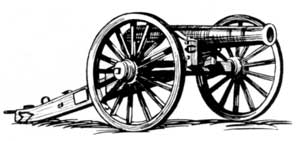|
GETTYSBURG National Military Park |
 |
Appendix
Weapons and
Tactics at Gettysburg
A variety of weapons was carried at Gettysburg. Revolvers, swords, and bayonets were abundant, but the basic infantry weapon of both armies was a muzzle-loading rifle musket about 4.7 feet long, weighing approximately 9 pounds. They came in many models, but the most common and popular were the Springfield and the English-made Enfield. They were hard hitting, deadly weapons, very accurate at a range of 200 yards and effective at 1,000 yards. With black powder, ignited by percussion caps, they fired "Minie Balls"—hollow-based lead slugs half an inch in diameter and an inch long. A good soldier could load and fire his rifle three times a minute, but in the confusion of battle the rate of fire was probably slower.
There were also some breech-loading small arms at Gettysburg. Union cavalrymen carried Sharps and Burnside single-shot carbines and a few infantry units carried Sharps rifles. Spencer repeating rifles were used in limited quantity by Union cavalry on July 3 and by a few Union infantry. In the total picture of the battle, the use of these efficient weapons was actually quite small.
Those who fought at Gettysburg with rifles and carbines were supported by nearly 630 cannon—360 Union and 270 Confederate. About half of these were rifled iron pieces, all but four of the others were smoothbore bronze guns. The same types of cannon were used by both armies.
Almost all of the bronze pieces were 12 pounders, either howitzers or "Napoleons." They could hurl a 12-pound iron ball nearly a mile and were deadly at short ranges, particularly when firing canister. Other bronze cannon included 24 pounder howitzers and 6 pounder guns. All types are represented in the park today, coated with patina instead of being polished as they were when in use.
Most of the iron rifled pieces at Gettysburg had a 3-inch bore and fired a projectile which weighed about 10 pounds. There were two types of these—3-inch ordnance rifles and 10 pounder Parrotts. It is easy to tell them apart for the Parrott has a reinforcing jacket around its breech, The effective range of these guns was somewhat in excess of a mile, limited in part because direct fire was used and the visibility of gunners was restricted.
Two other types of rifled guns were used at Gettysburg—four bronze James guns and two Whitworth rifles. The Whitworths were unique because they were breech loading and were reported to have had exceptional range and accuracy. However, their effect at Gettysburg must have been small for one was out of action much of the time.
These artillery pieces used three types of ammunition. All cannon could fire solid projectiles or shot. They also hurled fused, hollow shells which contained black powder and sometimes held lead balls or shrapnel. Canister consisted of cans filled with iron or lead balls. These cans burst apart on firing, converting the cannon into an oversized shotgun.
Weapons influenced tactics. At Gettysburg a regiment formed for battle, fought, and moved in a two rank line, its men shoulder to shoulder, the file closets in the rear. Since the average strength of regiments here was only 350 officers and men, the length of a regiment's line was a little over 100 yards. Such a formation brought the regiment's slow-firing rifles together under the control of the regimental commander, enabling him to deliver a maximum of fire power at a given target. The formation's shallowness had a two-fold purpose, it permitted all ranks to fire, and it presented a target of minimum depth to the enemy's fire.
Four or five regiments were grouped into a brigade, two to five brigades formed a division. When formed for the attack, a brigade moved forward in a single or double line of regiments until it came within effective range of the enemy line. Then both parties blazed away, attempting to gain the enemy's flank if feasible, until one side or the other was forced to retire. Confederate attacking forces were generally formed with an attacking line in front and a supporting line behind. Federal brigades in the defense also were formed with supporting troops in a rear line when possible. Breastworks were erected if time permitted, but troops were handicapped in this work because entrenching tools were in short supply.
Like their infantry comrades, cavalrymen also fought on foot, using their horses as means of transportation. However, mounted charges were also made in the classic fashion, particularly in the great cavalry battle on July 3.
Cavalry and infantry were closely supported by artillery. Batteries of from four to six guns occupied the crests of ridges and hills from which a field of fire could be obtained. They were usually placed in the forward lines, protected by supporting infantry regiments posted on their flanks or in their rear. Limbers containing their ammunition were nearby. Because gunners had to see their targets, artillery positions sheltered from the enemy's view were still in the future.


|

|
|
Last Modified: Mon, Mar 4 2002 10:00:00 pm PDT |


